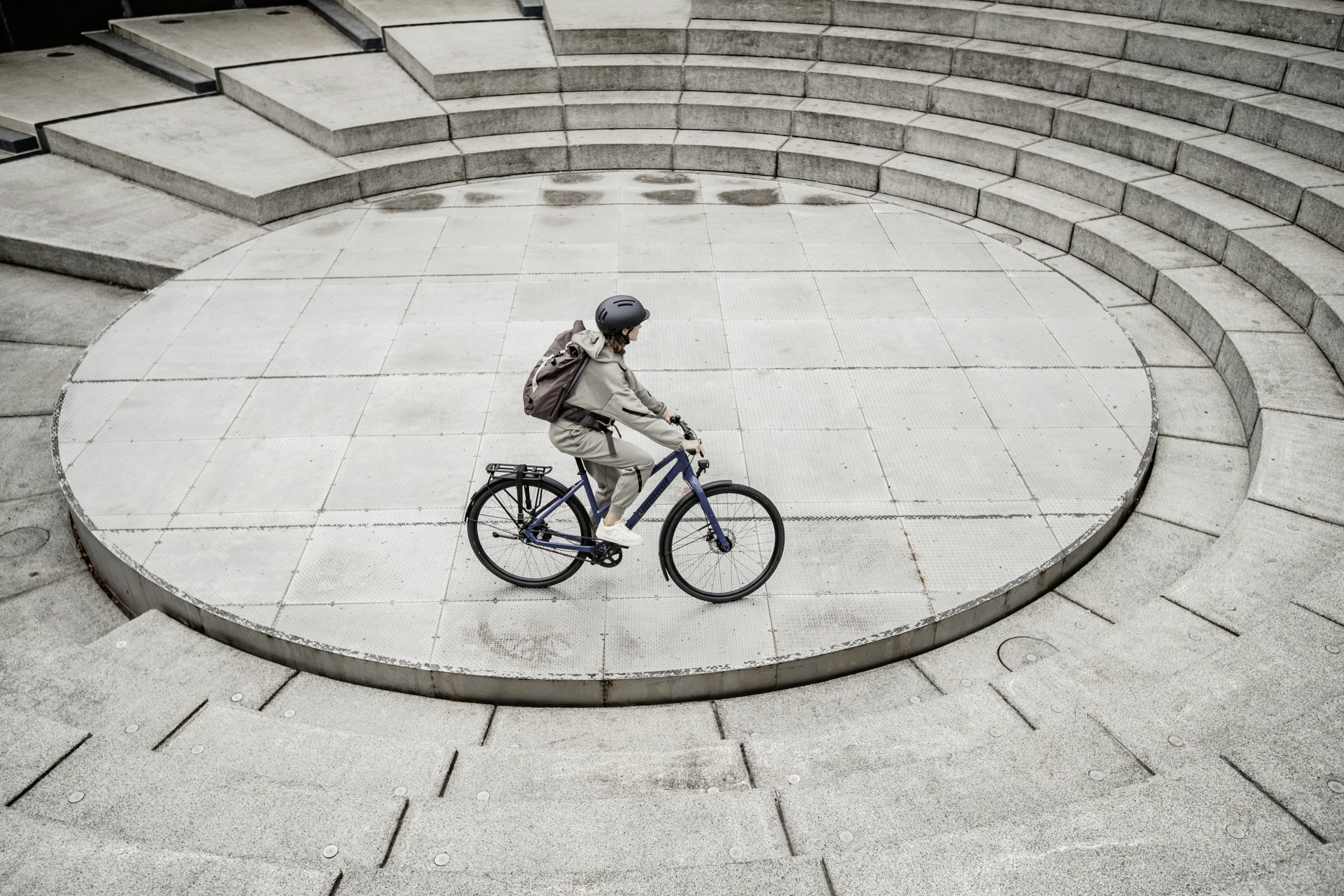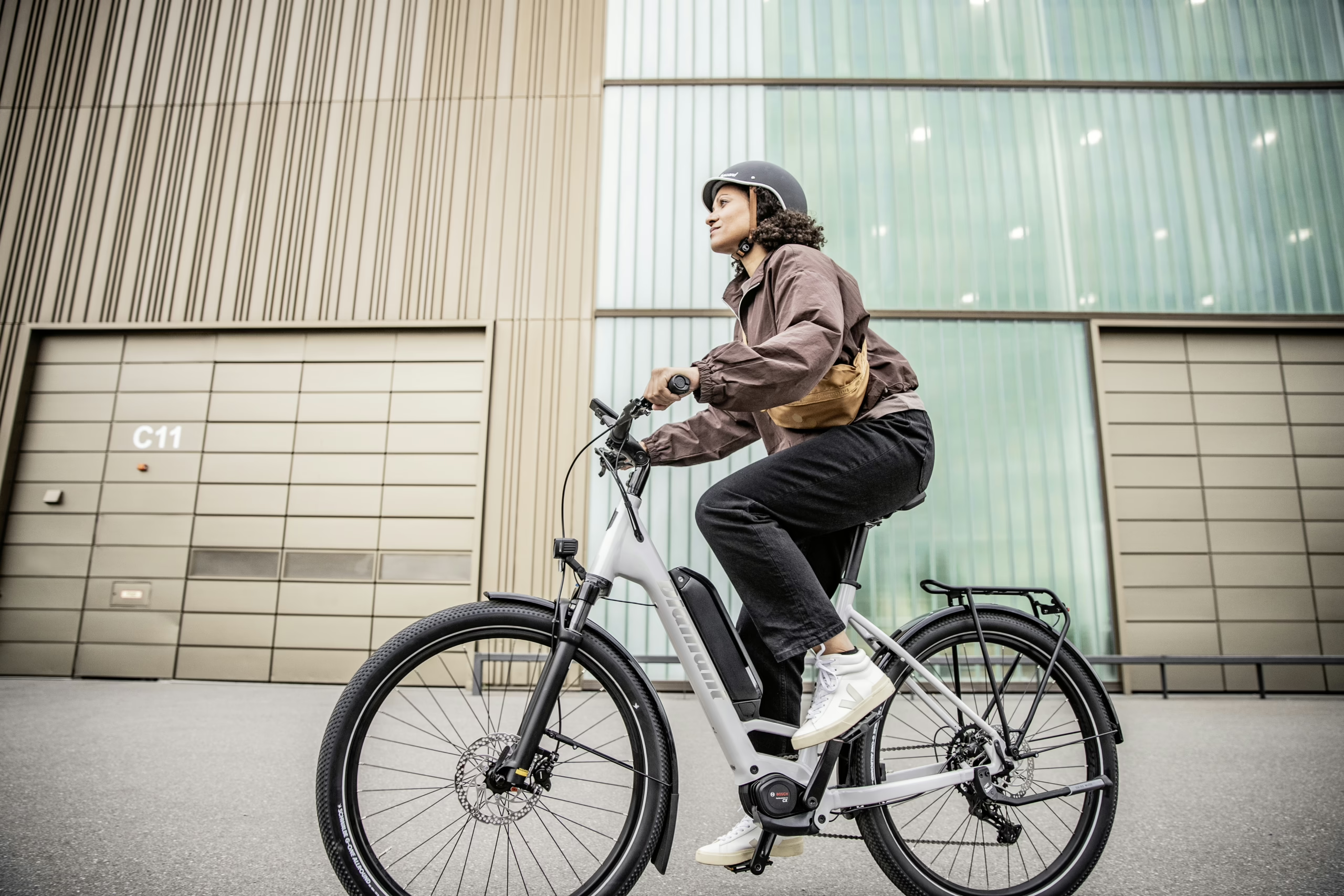
Women’s bikes
You’re here because you searched for “women’s bikes.” Many (maybe also you) might speak of “women’s bikes” when they talk about bikes with a lowered (or absent) top. We don’t mind. Everyone, man and woman, may buy a bike with lowstep or midstep frames, for active or casual riding, electric or without motor assistance, in black or colorful—regardless of how you or us label them. Simply search our product portfolio for your preferred step-through execution.
Further down we’ll add some recommendations for women to pay attention to when buying a new bike. Maybe you’re already grasping a key take-away: It’s not the shape of the frame, since every frame variant at Diamant is a unisex design.
Do women need different bikes?
Female anatomy is different from male anatomy. Men are on average 15% heavier and 10-15 cm taller. Other differences matter more. Women have a wider and more round-shaped pelvises with a slightly forward-tilted position. In exchange, they tend to have narrower shoulders. At identical height, their arms and legs are about 10% shorter, but their torsos are about 2-5% longer. And, yes, men have larger hands and feet.
While physical differences influence how a bike feels, they don’t merit separate bike designs. Just get the right fitting. There are so many ways to create the most ergonomic position on a modern bike that a woman and a man of the same height can ride the very same bike even though their bodies are otherwise very different. Read further down how to do that.
Consequently, we do not sell “women’s bikes”, but bikes with lower stepover height. The modern label focuses on the key differentiator. It’s a «midstep» or a «lowstep», but not a «stepover» frame.
Which bike size should women pick?
Diamant offers every bike in 2-4 sizes, and the geometry remains consistent across frame styles. For example, a size Large midstep frame has the same measurements as a size Large highstep frame.
Frame sizes overlap. A 174 cm (5’9″) rider with an 81 cm (32″) inseam could fit either a size M or L, depending on personal preferences and body. Two riders both 174 tall might take different decisions. And don’t forget: There’s as much variation within women and within men as there is between women and men.
Our frame geometry can accommodate for within-gender and across-gender variation. For instance, women tend to pick the smaller of two possible sizes in response to shorter limbs. We recommend a bike fitting at your local dealer to define your personal setup.

26” wheels vs. 28” wheels: The truth about wheel sizes
The historic «women’s bike» often featured small 26” wheels. The logic was as simple as it was flawed: If women are shorter, they need to be closer to the ground. Think about the evolution of mountainbikes. They used to run 26″ wheels to lower the point of gravity on faster trails. Today, larger 27.5” and 29” wheels have replaced smaller wheels. They perform better.
Larger wheels offer more comfort. They roll better over rough surfaces and curbs. The distance from bottom bracket to rear axle is longer – on steep ascents, front wheels do not lose contact as fast. On trekking® and city bikes, which often carry something on their rack, this additional length increases safety.
Body height has usually no influence on wheel size choices. Only very short people (around 152 cm height, 75 cm inseam) benefit from smaller wheels. Geometries tailored to their height wouldn’t fit larger wheels anymore.
How can women adjust their bikes for an optimal fit?
Women can fine-tune six components of their bikes to optimize comfort and performance. It’s handlebar (form and width), shift and brake levers (position), stem (length and angle), saddle (position, width, and shape), crank arms (length) and gear ratio.
Handlebars
Narrow handlebars suit narrower shoulders. A handlebar with generous backsweep creates an even more upright position.
Shift and brake levers
If you have small hands, you may alter the exact position of all levers flexibly. Sometimes you can also change the distance between lever and handlebar.
Stem
Stem length and stem angle jointly influence how upright or stretched out you will sit on the bike, but also how agile or not your bike will respond to your steering input. Even small variations like 10mm or 3° can substantially alter your ride experience.
Saddle
The saddle is one of the most flexible components on your bike. Not only height, but also tilt and horizontal alignment can vary. Many women, though not all, prefer wider saddles. Trained bike shops will always measure the optimal saddle width by analyzing the pressure points from your pelvis. Women who feel a lot of pressure in their intimate area tend to benefit from saddles with a gap or with a shorter nose.
Crank arm length
Crank arms can vary in length. Long crank arms reduce efficiency. Over time, they can cause damage to your knees. Some women and a growing number of men therefore prefer crank arms which are only 165 mm long or even shorter.
Gear ratio
The ratio between the largest and the smallest sprocket and the chainrings defines the gear ratio. As they tend to have a lower maximum power output, women benefit from riding less «heavy» gears and to rotate the pedal more frequently at the same speed. Our single chainring solutions optimize for smaller jumps between gears and omit the heaviest gears.

The «women’s bike» and the basket
Baskets are a handy addition to carry items quickly and conveniently. To attach a basket, you’ll need a suitable rack or mount. There are three main ways to attach a basket. Thankfully, these options are compatible with all frame styles. Get in touch with your trusted bikeshop and find your preferred basket from their well-curated offering.
You might attach your basket to your rear rack by means of an adapter. System racks by Racktime and Basil (MIK) make this particularly simple. The downside: You won’t see the luggage on the rear rack. In exchange, the basket won’t affect steering and bike handling.
Alternatively, you may attach your basket to a front-rack. We do not recommend that for most of our bikes. While the luggage is always in sight, they don’t work well with front suspension.
Finally, you could attach a basket to your handlebar. On e-bikes, the display can sometimes obstruct the installation. Specialized handlebar mounts are available to resolve this issue. Avoid overloading handlebar baskets, as their high center of gravity can affect steering stability.
Final words: What makes the best women’s bike?
The best “women’s bike” is the one that fits your unique needs. We appreciate that many women gravitate toward midstep and lowstep frames. We appreciate that women tend to have a stronger preference for more brighter and bolder designs. We have an eye for that when we make color choices. But we want to reiterate and underline: The frame style does not define what is a women’s bike—the rider does. Midstep and lowstep bikes can suit anyone who values comfort and ease of use, regardless of gender.
People are different. If a bike does not fit optimally on your test ride, some small adjustments might make a world of difference. We always recommend a trusted local dealer for anyone who is uncertain about how to make a bike fit perfectly.